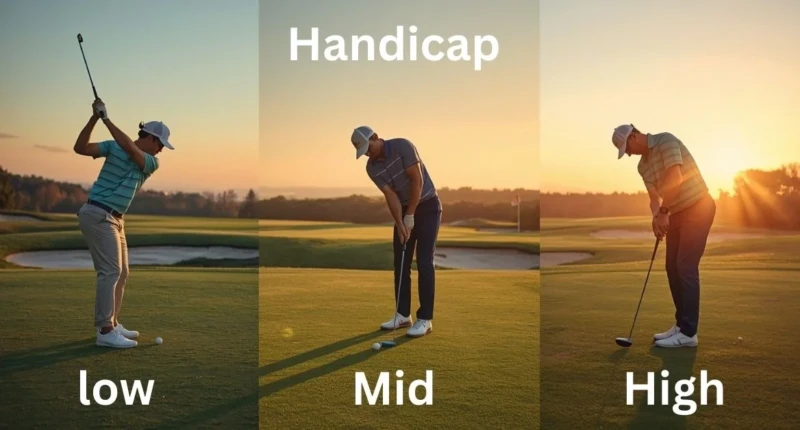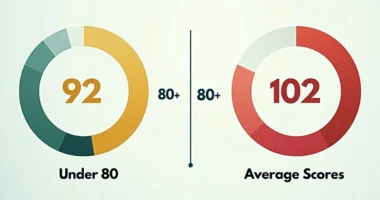A golf handicap is a number that represents a golfer’s potential ability based on their recent scores. The system allows players of different skill levels to compete fairly against one another.
- A scratch golfer has a handicap of 0, meaning they typically shoot par.
- A higher handicap golfer may have a handicap of 20, which means they usually shoot about 20 strokes above par.
Handicaps are calculated using official formulas set by organizations like the USGA (United States Golf Association) and World Handicap System (WHS). Most golfers, especially amateurs, fall between the 8 to 25 handicap range.
Handicap Ranges: Low, Mid, and High
Golfers are usually grouped into three broad handicap categories: low, mid, and high. Here’s how they break down:
1. Low Handicap (0 – 9)
- Who they are: Skilled players who consistently shoot close to par.
- Example: A golfer with a 5 handicap often shoots around 5 strokes above par.
Strengths:
- Strong consistency in driving and iron play.
- Good short game and putting under pressure.
- Excellent course management.
Weaknesses:
- Expectations are high, so mistakes feel costly.
- They still miss greens and fairways, but recover better than most.
Pro Tip: Low handicappers often chase scratch status. To get there, they focus on polishing the short game and mental discipline.
2. Mid Handicap (10 – 18)
- Who they are: The largest group of golfers, often weekend players.
- Example: A golfer with a 15 handicap typically shoots 15 strokes above par.
Strengths:
- Capable of hitting great shots, but not always consistently.
- Decent knowledge of swing mechanics and course play.
- Good potential to move into single-digit handicap territory with practice.
Weaknesses:
- Inconsistent ball striking.
- Struggles with accuracy, especially off the tee.
- Occasional blow-up holes that ruin an otherwise good round.
Pro Tip: Mid handicappers can see big improvements by focusing on driving accuracy and short game practice (chipping and putting).
3. High Handicap (19+)
Who they are: Beginners or casual golfers who are still learning the game.
Example: A golfer with a 25 handicap might shoot 100+ on a par-72 course.
Strengths:
- Passionate learners who enjoy the game regardless of score.
- Rapid improvement is possible with the right coaching.
Weaknesses:
- Frequent mishits and inconsistent swings.
- Limited distance and accuracy.
- Struggles with course management and reading greens.
Pro Tip: High handicappers should work on fundamentals: grip, stance, and consistent ball contact. Regular lessons and practice are more effective than chasing distance.
Key Differences Between Low, Mid, and High Handicaps
Let’s put the three categories side by side:
| Category | Handicap Range | Average Score (Par 72) | Skill Level | Main Focus |
| Low Handicap | 0 – 9 | 72–82 | Advanced | Fine-tuning, consistency |
| Mid Handicap | 10 – 18 | 82–92 | Intermediate | Accuracy & short game |
| High Handicap | 19+ | 92+ | Beginner/Casual | Fundamentals & practice |
Difference in Playing Style?
- Low handicappers tend to play aggressively but smartly. They go for birdies, attack flags, and rely on accuracy to minimize mistakes.
- Mid handicappers balance between safe play and risk. They may attempt tougher shots but often struggle with consistency.
- High handicappers usually play defensively, focusing more on simply keeping the ball in play rather than chasing low scores.
Difference in Mindset and Goals?
- Low handicap golfers are often chasing scratch or tournament-level performance. Their goals focus on fine-tuning and consistency.
- Mid handicap golfers want to break scoring barriers, such as shooting consistently in the 80s. Their main goal is to reduce double bogeys.
- High handicap golfers aim to enjoy the game, improve basic swing mechanics, and eventually break 100 or 90.
How to Improve Your Handicap?
Improvement is possible at every level. Here’s how golfers in each category can move forward:
For High Handicappers (19+)
- Focus on contact consistency (even short straight shots are better than long wild ones).
- Learn to manage the course, avoid hazards, and lay up when necessary.
- Spend 70% of practice time on short game (putting, chipping, pitching).
For Mid Handicappers (10–18)
- Identify your weakest area (driving, irons, or putting) and dedicate focused practice.
- Work on course strategy, play smart, not risky.
- Track stats (fairways hit, greens in regulation, putts) to find patterns.
For Low Handicappers (0–9)
- Maintain fitness and flexibility for consistent performance.
- Strengthening mental game, confidence, and patience matter.
- Practice under pressure to simulate tournament conditions.
Why Handicap Matters?
Some beginners wonder: Why does the handicap system even matter?
Here’s why it’s important:
- Fair Competition: A handicap lets golfers of different abilities compete evenly.
- Progress Tracking: It’s a clear indicator of how much you’re improving.
- Setting Goals: It helps players stay motivated to drop their number over time.
Without handicaps, golf would be much harder to enjoy for new players competing against skilled ones.
FAQs
1. What is considered a good golf handicap?
A handicap under 10 is generally considered good, while anything under 5 is excellent.
2. How long does it take to lower a handicap?
It depends on practice and dedication. Some players drop 5 strokes in a year, while others may take longer.
3. Can beginners get a handicap?
Yes! Anyone can establish a handicap by submitting scorecards through their golf club or a recognized system.
4. Do pros have handicaps?
Professional golfers don’t use handicaps since they compete at scratch (0) or better.
5. What is the maximum golf handicap?
According to the World Handicap System, the maximum is 54.0 for both men and women.
Final Thoughts
The difference between low, mid, and high handicap golfers comes down to skill, consistency, and experience.
- Low handicappers are skilled players striving for scratch golf.
- Mid handicappers make up the largest group, capable of good rounds but needing consistency.
- High handicappers are still learning but have plenty of room for improvement.
No matter where you fall, remember that golf is a game of patience and persistence. Handicaps are just numbers; they don’t measure your love for the game.
Related Topic: What Counts as a Good Golf Handicap?





